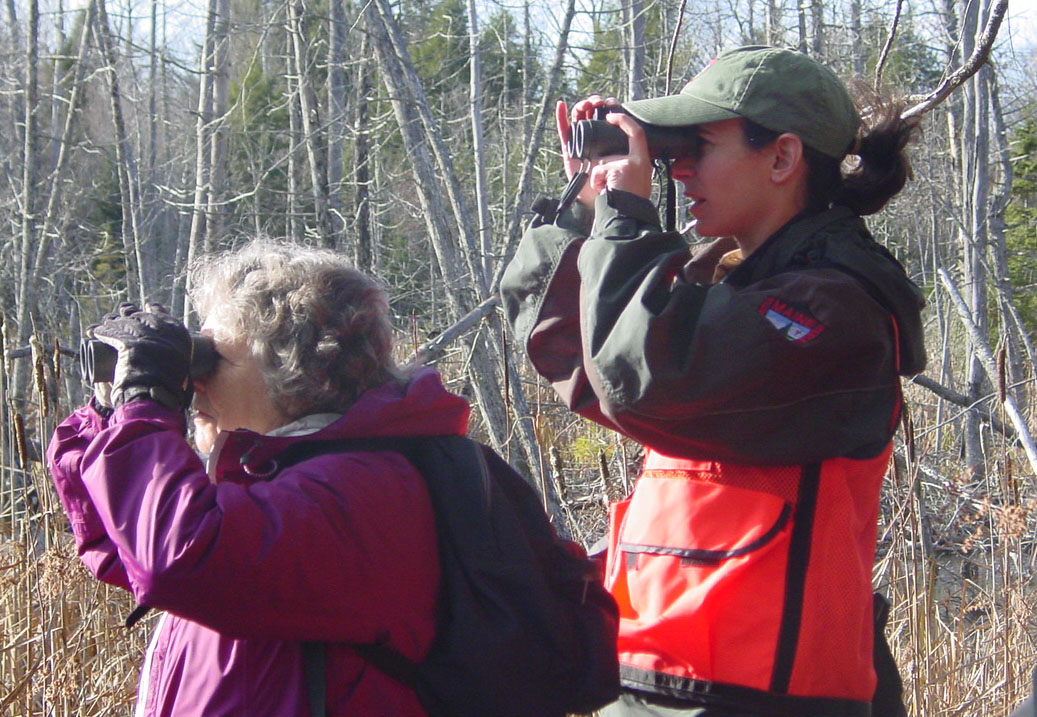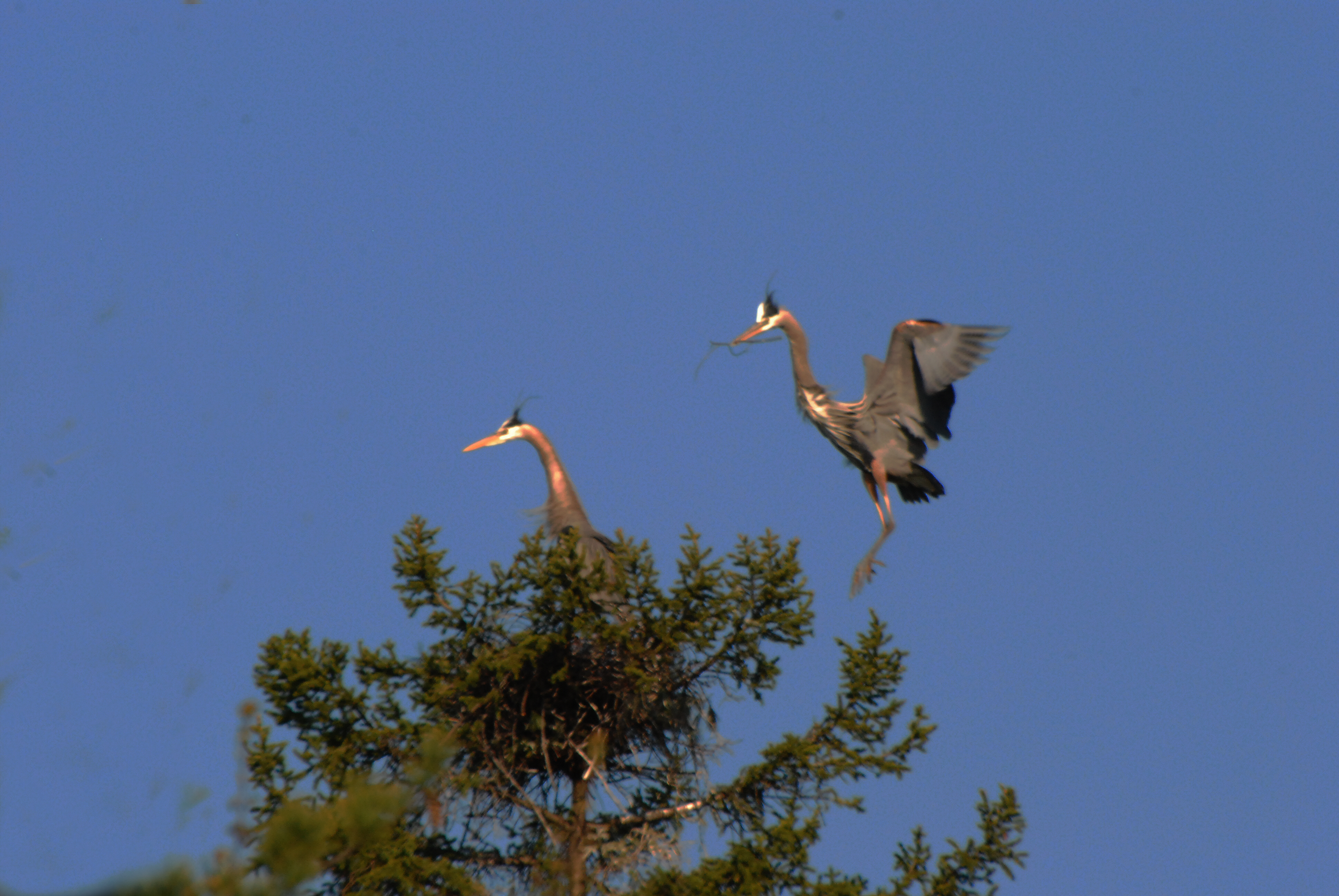March 10, 2011 at 3:29 pm
[caption id="attachment_545" align="alignleft" width="300" caption="In April 2009 at this colony in downeast Maine, ice-out is not yet complete and the herons have yet to return. Photo by Jonathan Mays."] [/caption]
The snowpack is gradually receding at my house. A remnant of our first snowman of the winter is poking its head out once more (so that’s where my hat went!). While I dread the looming mud season that will follow, I am excited that spring is really on its way. In fact, the Vernal Equinox is just around the corner: March 20th to be exact. Besides mud season, the arrival of spring also marks the return of great blue herons to Maine. Have you seen any herons yet? Feel free to post here or on Facebook to share your first heron observations of the season.
[caption id="attachment_550" align="alignleft" width="300" caption="A volunteer and I watch nesting herons from a distance."]
[/caption]
The snowpack is gradually receding at my house. A remnant of our first snowman of the winter is poking its head out once more (so that’s where my hat went!). While I dread the looming mud season that will follow, I am excited that spring is really on its way. In fact, the Vernal Equinox is just around the corner: March 20th to be exact. Besides mud season, the arrival of spring also marks the return of great blue herons to Maine. Have you seen any herons yet? Feel free to post here or on Facebook to share your first heron observations of the season.
[caption id="attachment_550" align="alignleft" width="300" caption="A volunteer and I watch nesting herons from a distance."] [/caption]
Whether or not you see one of the first herons to arrive in Maine is not important. What is more important is ensuring that each of our wading bird colonies is being monitored by a member of the Heron Observation Network. The Heron Observation Network is a network of volunteers who have adopted colonies across the state. By adopting a colony, volunteers make observations at the colony during the breeding season and report the data back to MDIFW. Over time, this data will help to reveal population trends of each colonial wading bird species and help guide future management.
[caption id="attachment_555" align="alignleft" width="300" caption="During the nest building stage, a great blue heron brings a twig to its mate. Photo by Al Larson."]
[/caption]
Whether or not you see one of the first herons to arrive in Maine is not important. What is more important is ensuring that each of our wading bird colonies is being monitored by a member of the Heron Observation Network. The Heron Observation Network is a network of volunteers who have adopted colonies across the state. By adopting a colony, volunteers make observations at the colony during the breeding season and report the data back to MDIFW. Over time, this data will help to reveal population trends of each colonial wading bird species and help guide future management.
[caption id="attachment_555" align="alignleft" width="300" caption="During the nest building stage, a great blue heron brings a twig to its mate. Photo by Al Larson."] [/caption]
MDIFW knows of approximately 100 active great blue heron colonies in Maine and has found volunteers to monitor many of them. However, there are still approximately 40 colonies that have not been adopted. Adoption includes a minimum of 1 visit during the peak of the breeding season which is mid-May to mid-June. For those with the interest and time, additional observations can be made at 2-week intervals in an effort to capture breeding effort and success information for the season. Observations are only done if disturbance to the nesting birds can be avoided. Binoculars are necessary, and a scope is often very helpful. Data recorded include the number of active and inactive nests, the breeding stage of each nest (incubation, nestling, fledgling), and the number of nestlings and fledglings seen.
Below is a list of the towns where colonies needing adoption are located. Contact me if you are interested in adopting a colony or if you know of a colony that we may not yet know about.
[/caption]
MDIFW knows of approximately 100 active great blue heron colonies in Maine and has found volunteers to monitor many of them. However, there are still approximately 40 colonies that have not been adopted. Adoption includes a minimum of 1 visit during the peak of the breeding season which is mid-May to mid-June. For those with the interest and time, additional observations can be made at 2-week intervals in an effort to capture breeding effort and success information for the season. Observations are only done if disturbance to the nesting birds can be avoided. Binoculars are necessary, and a scope is often very helpful. Data recorded include the number of active and inactive nests, the breeding stage of each nest (incubation, nestling, fledgling), and the number of nestlings and fledglings seen.
Below is a list of the towns where colonies needing adoption are located. Contact me if you are interested in adopting a colony or if you know of a colony that we may not yet know about.
 [/caption]
The snowpack is gradually receding at my house. A remnant of our first snowman of the winter is poking its head out once more (so that’s where my hat went!). While I dread the looming mud season that will follow, I am excited that spring is really on its way. In fact, the Vernal Equinox is just around the corner: March 20th to be exact. Besides mud season, the arrival of spring also marks the return of great blue herons to Maine. Have you seen any herons yet? Feel free to post here or on Facebook to share your first heron observations of the season.
[caption id="attachment_550" align="alignleft" width="300" caption="A volunteer and I watch nesting herons from a distance."]
[/caption]
The snowpack is gradually receding at my house. A remnant of our first snowman of the winter is poking its head out once more (so that’s where my hat went!). While I dread the looming mud season that will follow, I am excited that spring is really on its way. In fact, the Vernal Equinox is just around the corner: March 20th to be exact. Besides mud season, the arrival of spring also marks the return of great blue herons to Maine. Have you seen any herons yet? Feel free to post here or on Facebook to share your first heron observations of the season.
[caption id="attachment_550" align="alignleft" width="300" caption="A volunteer and I watch nesting herons from a distance."] [/caption]
Whether or not you see one of the first herons to arrive in Maine is not important. What is more important is ensuring that each of our wading bird colonies is being monitored by a member of the Heron Observation Network. The Heron Observation Network is a network of volunteers who have adopted colonies across the state. By adopting a colony, volunteers make observations at the colony during the breeding season and report the data back to MDIFW. Over time, this data will help to reveal population trends of each colonial wading bird species and help guide future management.
[caption id="attachment_555" align="alignleft" width="300" caption="During the nest building stage, a great blue heron brings a twig to its mate. Photo by Al Larson."]
[/caption]
Whether or not you see one of the first herons to arrive in Maine is not important. What is more important is ensuring that each of our wading bird colonies is being monitored by a member of the Heron Observation Network. The Heron Observation Network is a network of volunteers who have adopted colonies across the state. By adopting a colony, volunteers make observations at the colony during the breeding season and report the data back to MDIFW. Over time, this data will help to reveal population trends of each colonial wading bird species and help guide future management.
[caption id="attachment_555" align="alignleft" width="300" caption="During the nest building stage, a great blue heron brings a twig to its mate. Photo by Al Larson."] [/caption]
MDIFW knows of approximately 100 active great blue heron colonies in Maine and has found volunteers to monitor many of them. However, there are still approximately 40 colonies that have not been adopted. Adoption includes a minimum of 1 visit during the peak of the breeding season which is mid-May to mid-June. For those with the interest and time, additional observations can be made at 2-week intervals in an effort to capture breeding effort and success information for the season. Observations are only done if disturbance to the nesting birds can be avoided. Binoculars are necessary, and a scope is often very helpful. Data recorded include the number of active and inactive nests, the breeding stage of each nest (incubation, nestling, fledgling), and the number of nestlings and fledglings seen.
Below is a list of the towns where colonies needing adoption are located. Contact me if you are interested in adopting a colony or if you know of a colony that we may not yet know about.
[/caption]
MDIFW knows of approximately 100 active great blue heron colonies in Maine and has found volunteers to monitor many of them. However, there are still approximately 40 colonies that have not been adopted. Adoption includes a minimum of 1 visit during the peak of the breeding season which is mid-May to mid-June. For those with the interest and time, additional observations can be made at 2-week intervals in an effort to capture breeding effort and success information for the season. Observations are only done if disturbance to the nesting birds can be avoided. Binoculars are necessary, and a scope is often very helpful. Data recorded include the number of active and inactive nests, the breeding stage of each nest (incubation, nestling, fledgling), and the number of nestlings and fledglings seen.
Below is a list of the towns where colonies needing adoption are located. Contact me if you are interested in adopting a colony or if you know of a colony that we may not yet know about.
| Town | Colony# |
| Andover | 609 |
| Anson | 658 |
| Buckfield | 714 |
| Burnham | 175 |
| Burnham | 632 |
| Chesterville | 697 |
| China | 681 |
| Eddington | 640 |
| Edinburg | 695 |
| Edinburg | 723 |
| Edinburg | 727 |
| Eliot | 100 |
| Eliot | 646 |
| Fairfield | 745 |
| Gray | 670 |
| Greenbush | 718 |
| Greenbush | 740 |
| Hancock | 701 |
| Harpswell | 4 |
| Lagrange | 746 |
| Lyman | 704 |
| Lynchtown Twp | 131 |
| Mercer | 689 |
| Monmouth | 744 |
| Muscle Ridge Shoals Twp | 725 |
| Orneville Twp | 675 |
| Paris | 604 |
| Parsonsfield | 185 |
| Passadumkeag | 741 |
| Sidney | 605 |
| Stetson | 629 |
| Stow | 109 |
| Surry | 179 |
| T4 R3 WELS | 726 |
| Unity | 115 |
| Waldo | 688 |
| Westfield | 510 |
| Westport Island | 711 |